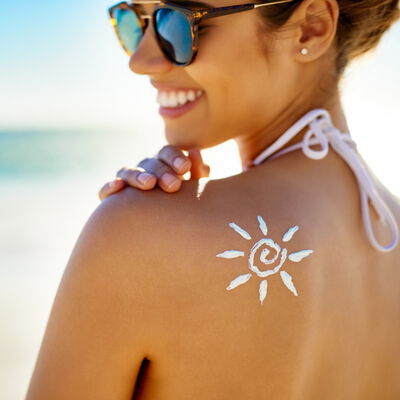
Beyond UV: How SPF Sunscreens Now Shield Against Blue Light and Pollution
If you spend hours in front of screens or live in a busy city, your skin is exposed to more than just the sun. Blue light from digital devices and environmental pollution can also damage your skin barrier, cause pigmentation, and speed up ageing.
That’s where modern SPF sunscreens step in. The best sunscreens today don’t just offer UV protection—they’re packed with ingredients that help block blue light, neutralise pollutants, and support your skin's natural defence.
In this blog, we’ll break down how SPF sunscreens are evolving to meet the needs of daily urban life, what to look for on the label, and how to build a skincare routine that works harder for your skin.

The Evolution of Sunscreens – More Than Just UV Protection
Sunscreens have come a long way from being basic sunblocks that only shielded against sunburn. Earlier, the goal was simple—guard the skin from UVB rays. But as our understanding of environmental stressors has expanded, so has the role of sunscreens.
Modern sunscreens are now designed to offer multi-layered protection. In addition to UVA and UVB, many advanced formulas also guard against blue light and urban pollutants, both of which can accelerate ageing, dullness, and sensitivity. Whether you're working in front of a screen or commuting through a crowded city, your sunscreen now needs to do more than ever.
What Are We Protecting Against Now?
Your daily sunscreen routine isn’t just about the sun anymore. Here's what else your skin needs defence from:
Blue Light (HEV Light)
High-Energy Visible (HEV) light—also called blue light—comes mainly from screens (laptops, phones, tablets), and even indoor LED lighting. Long-term exposure may:
- Trigger premature ageing and hyperpigmentation
- Weaken the skin’s natural barrier
- Contribute to inflammation and dullness
Look for sunscreens labelled with blue light protection. These often contain antioxidants like vitamin C, niacinamide, or iron oxides neutralise HEV-induced damage.
Urban Pollution
City environments expose your skin to fine dust particles, car emissions, smoke, and other pollutants that clog pores and degrade collagen. Over time, this leads to:
- Uneven skin tone and dullness
- Increased sensitivity and inflammation
- Accelerated signs of ageing, like wrinkles and loss of firmness
Sunscreens with anti-pollution properties form a physical or antioxidant barrier on the skin. Ingredients like niacinamide, vitamin E, and green tea extract help defend against daily environmental stress.
How Modern SPF 50 Sunscreens Combat Blue Light & Pollution
With more time spent in front of screens and living in high-pollution environments, your sunscreen needs to do more than just block UV rays. Modern sunscreen SPF 50 formulas are built to defend your skin against everyday stressors like blue light and airborne pollutants. Let’s break down how they work.
Ingredients That Do the Heavy Lifting
Modern sunscreens are packed with multitasking ingredients that go beyond sun protection:
- Iron oxides: These help block visible light, especially blue light emitted from phones, laptops, and LED lighting.
- Antioxidants: These, such as niacinamide, vitamin C, and green tea extract, help neutralise free radicals caused by pollution and UV exposure.
- Zinc oxide and titanium dioxide: These mineral filters provide broad-spectrum protection without irritating the skin, making them ideal for sensitive skin types.
- Hyaluronic acid and glycerin: These keep the skin hydrated, counteracting the dryness that pollution and blue light can cause.
Formulas Designed for Urban Skin Stress
The best SPF for face in urban settings does more than just shield—it also repairs and strengthens your skin barrier:
- Non-comedogenic and breathable textures prevent clogged pores, even when exposed to grime and sweat.
- Anti-pollution SPF blends actives that create an invisible barrier on the skin, reducing pollutant penetration.
- Lightweight sunscreen SPF 50 formulations are ideal for daily city use, offering long-lasting coverage without feeling greasy.
- Some formulas now even combine blue light protection, anti-ageing benefits, and moisturisation, giving you a streamlined skincare step that fits into your routine.
Choosing the Best SPF for Face in Today’s Environment
Your sunscreen isn’t just about sun protection anymore—it’s also your first line of defence against environmental stressors like pollution, blue light, and harsh weather. The best SPF for the face should offer broad-spectrum protection, suit your skin type, and feel comfortable enough for daily wear.
Look for sunscreen SPF 50 if you're outdoors often or exposed to high pollution levels. Choose formulas that are non-comedogenic, lightweight, and enriched with antioxidants for added defence. Mineral sunscreens with zinc oxide or titanium dioxide are also a great option for sensitive skin.
You can also use the Cetaphil AI Skin Analysis Tool for personalised product recommendations based on your skin type. It helps you narrow down the right sunscreen for your specific needs, whether oily, dry, or sensitive.
Daily Skincare Routine with Anti-Pollution SPF
Incorporating an anti-pollution SPF into your daily skincare routine doesn’t have to be complicated. Here’s a simple 3-step morning routine to keep your skin protected and balanced:
- Cleanse: Start with a gentle face cleanser to remove impurities and prep your skin.
- Moisturise: Use a lightweight moisturiser to maintain hydration and support the skin barrier.
- Protect: Apply a sunscreen SPF 50 that provides broad-spectrum and anti-pollution protection. Make sure to reapply every 2–3 hours if you're outside or exposed to screens for long periods.
Recommended Cetaphil Sunscreens
Here are a few dermatologist-recommended Cetaphil sunscreens that are great for daily use, especially in polluted or urban settings:
- Cetaphil Sun SPF 50+ Light Gel: This lightweight, non-greasy gel is ideal for oily to combination skin. It offers high UVA/UVB protection and absorbs quickly.
- Cetaphil Sun SPF 30 Face Lotion: Enriched with vitamin E and suitable for sensitive skin. Provides reliable sun protection without clogging pores.
- Cetaphil Sun Kids Liposomal Lotion SPF 50+: While designed for kids, this gentle, high-protection formula works well for adults with very sensitive or reactive skin.
FAQs
What’s the difference between SPF 30 and SPF 50?
SPF 30 blocks about 97% of UVB rays, while sunscreen SPF 50 blocks around 98%. While the difference in percentage seems small, SPF 50 offers better protection if you're spending long hours outdoors. For most people, SPF 30 is enough for daily use, but if you have fair or sensitive skin or live in a high UV index area, sunscreen with SPF 50 can be a safer choice.
Does sunscreen really protect against blue light?
Yes, some sunscreens do offer protection against blue light, especially those with iron oxides or antioxidants like niacinamide and vitamin C. If you’re often in front of screens, look for the best SPF for a face that includes blue light defence on the label. It's a smart step in preventing early signs of ageing and uneven skin tone.
What is anti-pollution SPF?
Anti-pollution SPF is a sunscreen that protects against UV rays and helps shield the skin from pollutants like fine dust and smog. These sunscreens often contain antioxidants to neutralise free radicals and form a barrier on the skin. They're ideal if you live in urban areas with high pollution levels.
Can I use the same sunscreen for indoor and outdoor use?
You can use the same broad-spectrum sunscreen indoors and outdoors if it offers broad-spectrum protection. However, when outside for extended periods, opt for sunscreen SPF 50 or higher and reapply every 2 hours. For indoors, a lighter formula with SPF 30 may be enough. Choose the best SPF for your face that fits your routine and skin type for everyday wear.







.png?sw=450&sh=450&sm=fit&q=85)






